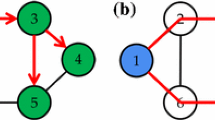Abstract
The criticality of survivable network design and operation increases with increasing transmission speed. Path protection strategies achieve better network utilization compared to link protection strategies; however, the recovery time of connections in path protection strategies are higher than that in link protection strategies. This paper evaluates and compares the performance of three failure dependent strategies: (1) failure dependent path protection; (2) link protection; and (3) Diversion—a variant of the segmented path protection approach. In addition, a framework for evaluating the connection recovery time is also developed. The protection strategies are compared for their recovery time and blocking performance using extensive simluations.
Similar content being viewed by others
References
Jue, J., Xiao, G.: An adaptive routing algorithm for wavelength-routed optical networks with a distributed control scheme. In: Proceedings of the Nineth International Conference on Computer Communications and Networks, pp. 192–197. Las Vegas, NV, USA (2000)
Zang, H., Shasrabuddhe, L., Jue, J.P., Ramamurthy, S., Connection management for wavelength-routed WDM networks. In: Global Telecommunications Conference, GLOBECOM’99, vol. 2, pp. 1428–1432. Rio de Janeiro, Brazil (1999)
Mokhtar A., Azizoglu M. (1998). Adaptive wavelength routing all-optical networks. IEEE Trans. Networking 6(2):197–206
Zang, H., Jue, J., Sahasrabuddhe, L., Ramamurthy, R., Dynamic lightpath establishment in wavelength-routed WDM networks. IEEE Commun. 100–108 (September 2001)
Ramamurthy, S., Mukherjee, B.: Fixed alternate routing and wavelength conversion in wavelength-routed optical networks. In: Proceedings of the Global Telecommunications Conference, GLOBECOM’98, pp. 2295–2303. Sydney, Australia (1998)
Lowe, E.D., Hunter, D.K.: Performance of dynamic path optical networks. In: IEE-Proceedings of Optoelectronics, pp. 235–239. (August 1997)
Li L., Somani A.K. (1999). Dynamic wavelength routing using congestion and neighborhood information. IEEE Trans. Networking 7(5):779–786
Zhang, X., Qiao, C.: Wavelength assignment for dynamic traffic in multi-fiber WDM networks. In 7th International Conference on Computer Communication and Networks, pp. 479–485. Lafayette, LA, USA (October 1998)
Wen, B., Sivalingam, K.M.: Routing, wavelength and time-slot assignment in time division multiplexed wavelength-routed optical WDM networks. In: Proceedings of IEEE INFOCOM’02, pp. 1442–1450. New York, NY, USA (June 2002)
Zhu, K., Mukherjee, B.: Traffic grooming in an optical WDM network. In: IEEE International Conference on Communications, pp. 721–725 (June 2001)
Srinivasan, R.: MICRON: A framework for connection establishment in optical networks. In: Proceedings of OPTICOMM, pp. 139–150. Dallas, TX, USA (October 2003)
Grover W.D. (2003). Mesh-based Survivable Networks: Options and Strategies for Optical, MPLS, SONET and ATM Networking. Prentice Hall Publishers, New Jersey, USA
Sathyamurthy, K., Ramasubramanian, S.: Benefits of link protection at connection granularity. In: Proceedings of IEEE International Conference on Broadband Networks (BROADNETS), pp. 300–309 (October 2004)
Ramasubramanian, S.: On failure dependent protection in optical grooming networks. In: IEEE International Conference on Dependable Systems and Networks (DSN), pp. 475–484. Florence, Italy (June–July 2004)
Fredrick, M.T., Somani, A.K.: A single-fault recovery strategy for optical networks using subgraph routing. In: Proceedings of the 7th IFIP Working Conference on Optical Network Design and Modelling, pp. 327–346. Budapest, Hungary (February 2003)
Patel, M., Chandrasekaran, R., Venkatesan, S.: A comparative study of restoration schemes and spare capacity assignments in mesh networks. In: Proceedings of 12th International Conference on Computer Communications and Networks (pp. 399–404) (October 2003).
Ramasubramanian, S., Sathyamurthy, K.: Supporting multiple protection strategies in optical networks. Technical Report, Department of Electrical and Computer Engineering, University of (November 2004).
Srinivasan, R., Somani, A.K.: Request-specific routing in WDM grooming networks. In: Proceedings of IEEE International Conference on Communications (ICC 2002), pp. 2876–2880. New York, NY, USA (April 2002).
Author information
Authors and Affiliations
Corresponding author
Rights and permissions
About this article
Cite this article
Ramasubramanian, S., Harjani, A.S. Comparison of failure dependent protection strategies in optical networks. Photon Netw Commun 12, 195–210 (2006). https://doi.org/10.1007/s11107-006-0028-z
Received:
Revised:
Accepted:
Published:
Issue Date:
DOI: https://doi.org/10.1007/s11107-006-0028-z




